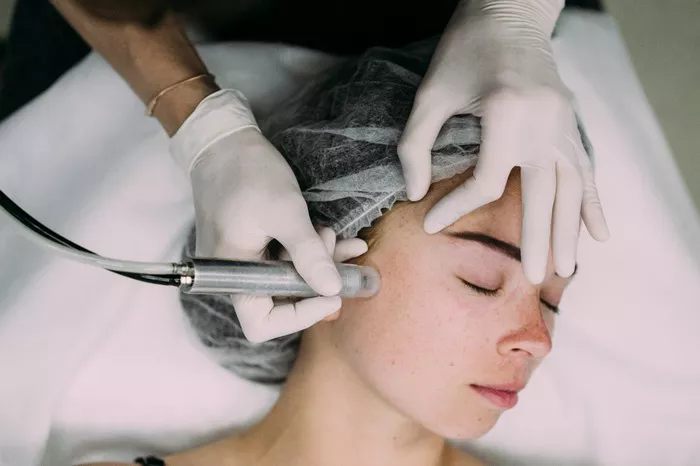Microdermabrasion is a popular skincare procedure that can help rejuvenate the skin and improve its overall appearance. It is a non-invasive treatment that exfoliates the skin, removing dead skin cells and stimulating cell turnover. If you’re considering microdermabrasion or simply curious about the process, this article will guide you through the five steps involved in microdermabrasion treatment.
Step 1: Cleansing the Skin
The first step in a microdermabrasion treatment is cleansing the skin thoroughly. This step is crucial to remove any traces of makeup, oil, or dirt that may be present on the surface of the skin. A gentle cleanser is used to ensure that the skin is clean and ready for the exfoliation process. The skincare professional will carefully cleanse the face, neck, or any other area that is being treated to create a clean canvas for the subsequent steps.
Step 2: Prepping the Skin
After cleansing, the skincare professional will prepare the skin for the microdermabrasion treatment. This step typically involves applying a toner or a prepping solution to balance the pH levels of the skin and enhance the effectiveness of the exfoliation. The toner also helps remove any residue left after cleansing and further prepares the skin for the exfoliation process. Prepping the skin ensures that the treatment can deliver optimal results by promoting better product penetration and exfoliation.
Step 3: Exfoliation with Microdermabrasion
The core step of microdermabrasion is the actual exfoliation of the skin. During this step, a handheld device is used to gently and evenly exfoliate the outer layer of the skin. The device may utilize tiny crystals or a diamond-tipped wand to abrade the skin’s surface, removing dead skin cells and stimulating collagen production. The device is moved across the treatment area in a controlled manner, exfoliating the skin and creating a more even and smooth texture.
The exfoliation process works by removing the dead and damaged skin cells, which can help improve various skin concerns such as fine lines, wrinkles, acne scars, and sun damage. By removing the outer layer of the skin, microdermabrasion also promotes the regeneration of new, healthier skin cells.
Step 4: Vacuuming and Suction
In conjunction with the exfoliation, microdermabrasion also involves vacuuming or suctioning away the exfoliated particles and dead skin cells. This step helps to keep the treatment area clean and removes any debris left behind from the exfoliation process. The vacuuming action also stimulates blood flow, bringing oxygen and nutrients to the skin, which can contribute to a more youthful and radiant complexion.
The intensity of the vacuuming or suction can be adjusted based on the individual’s skin type and sensitivity. It is a gentle and painless process that contributes to the overall effectiveness of the treatment.
Step 5: Hydration and Protection
After the exfoliation and vacuuming steps, the skin may be slightly sensitive and more receptive to skincare products. In this final step, the skincare professional will apply a hydrating and soothing moisturizer or serum to the treated area. This helps to replenish moisture and nourish the skin, promoting its healing and rejuvenation.
Additionally, a broad-spectrum sunscreen with a high SPF is applied to protect the newly exfoliated skin from harmful UV rays. Since the exfoliated skin is more vulnerable to sun damage, sunscreen is crucial to maintain the results of the treatment and prevent any potential pigmentation issues.
Post-Treatment Care and Recommendations
After completing the microdermabrasion treatment, there are a few important post-treatment care recommendations to follow:
Avoid sun exposure: It’s crucial to protect your skin from the sun’s harmful rays after microdermabrasion. Wear a wide-brimmed hat and apply sunscreen regularly to minimize the risk of pigmentation issues and protect the newly exfoliated skin.
Keep the skin moisturized: Apply a gentle moisturizer to keep the skin hydrated and support its healing process. Opt for products that are free of fragrances or harsh ingredients to avoid any potential irritation.
Avoid harsh skincare products: Refrain from using harsh exfoliants, chemical peels, or retinol products for a few days after the treatment. Allow your skin to recover fully before reintroducing any potentially irritating or aggressive skincare products.
Follow the skincare professional’s instructions: Your skincare professional will provide specific guidelines and recommendations based on your skin type and the intensity of the treatment. Follow their instructions carefully to ensure optimal healing and results.
Conclusion
Microdermabrasion is a popular and effective skincare treatment that can help rejuvenate the skin and improve its texture and appearance. Understanding the five steps involved in a microdermabrasion treatment – cleansing, prepping, exfoliating, vacuuming, and hydrating – can help you make an informed decision about whether this treatment is right for you. By following proper post-treatment care and recommendations, you can maximize the benefits of microdermabrasion and achieve a more youthful and radiant complexion. Remember to consult with a skincare professional to determine if microdermabrasion is suitable for your skin type and to receive personalized guidance throughout the treatment process.

